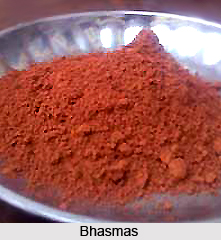 In addition to rasayanas, Ayurveda has also taken recourse to use of metals, jewels, and pearls as medicines. These elements are turned into calxes or bhasmas for administration in different diseases. The human body contains some chemical elements, which are known as trace elements, that is, elements whose mere traces are to be found in the human body. The trace elements are distributed throughout the tissues of the body in very small amounts and are essential for the nutrition of the body. Nine such elements are now recognized as cobalt, copper, fluorine, iodine, iron, manganese, molybdenum, selenium, and zinc. No wonder Ayurveda has always taken recourse to calxes of precious and other metals for dealing with certain deficiency diseases. Calyxes of gold, silver, copper, and iron are widely used.
In addition to rasayanas, Ayurveda has also taken recourse to use of metals, jewels, and pearls as medicines. These elements are turned into calxes or bhasmas for administration in different diseases. The human body contains some chemical elements, which are known as trace elements, that is, elements whose mere traces are to be found in the human body. The trace elements are distributed throughout the tissues of the body in very small amounts and are essential for the nutrition of the body. Nine such elements are now recognized as cobalt, copper, fluorine, iodine, iron, manganese, molybdenum, selenium, and zinc. No wonder Ayurveda has always taken recourse to calxes of precious and other metals for dealing with certain deficiency diseases. Calyxes of gold, silver, copper, and iron are widely used.
Jewels or ratnas include precious and semi-precious stones, which are turned into calxes and used as drugs because of their therapeutic properties. Major jewels or maharatnas can be mentioned as diamond or hiraka, ruby or manikya, pearl or mukta, topaz or pushparaga, sapphire or neelam, emerald or tarksha, cat`s eye or vaidurya, zircon or gomedak, and coul or vidruma. Uparatnas or minor jewels can be named as turmulin or vaikranta, sun-stone or suryakanta, moonstone or chandrakanta, lapis lazuli or rajavarta, turquoise or pheroza, and crystal or sphatika.
Calyxes of these stones are formed by following the correct pharmaceutical procedures like that of titration and repeated heating. They are then ground into fine powders. Minute doses, even 50 mg of these preparations, are given for the amelioration of morbid conditions. They are also used for the purposes of vajikarana that is, increasing sexual vigour; and also rejuvenation.
The various calyxes have different properties. As for example, in cases of severe anaemia or blood loss due to injuries, Lauha Bhasma i.e. calx of iron is given. It is just like a modem physician giving iron tablets to his patients. The only difference being that Lauha Bhasma is more readily assimilated into the system, whereas the fersolate tablets are passed through the stool. This happens because the system cannot absorb iron in that raw and rough shape. The calx of diamond is a powerful cardiac tonic and one of the best elixirs. It is helpful in curing diabetes, urinary troubles, anaemia, oedema, and even impotence, because it is a powerful aphrodisiac.
The calx of rubies on the other hand promotes intelligence, virility, longevity; and also cures disorders produced by the vitiation of the three doshas, including consumption. The calx of pearls has a cooling effect on the system and cures the burning sensation in various parts of the body, fevers, and chronic urinary infections. It also promotes growth of bones and the teeth, and is an anti-toxin. The calx of topaz has a cooling and carminative effect. It promotes digestion and is used in certain serious afflictions of the skin like leprosy and other disorders caused by the aggravation of vata and kapha. It is also useful in cases where the patients are unable to put on weight in spite of a normal diet. The calx of sapphire promotes virility and digestion. It also ensures a healthy complexion and is a wonderful remedy in cases of a fistula, piles, skin diseases like leprosy, and pulmonary afflictions like asthma and bronchitis. The calx of emerald is a known remedy for providing immunity against disease and is helpful in cases of anaemia, oedema, and other disorders caused by the vitiation of all the three doshas. The calx of cat`s eye is a laxative and promotes digestion and eye-sight. It also helps in stopping haemorrhages and disorders attendant upon aggravation of pitta. Gomeda is a carminative and helps in dealing with disorders of the digestion like anorexia. Coral is alkaline and promotes digestion and virility. It is also an anti-toxin and is a wonderful remedy for night sweats.
It is in the sphere of rasayanas and the various bhasmas that Ayurveda has proved its superiority. Maintenance of bodily and mental vigour are the main objective of rasayana. And this is only possible through recourse to Ayurveda.





